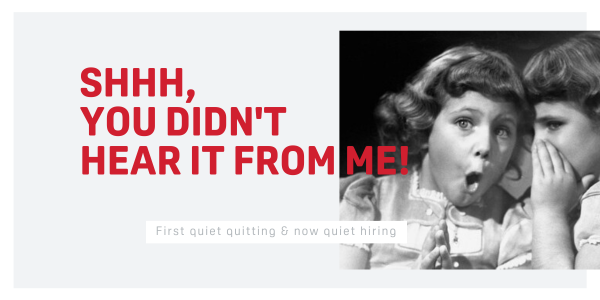First quiet quitting now it’s quiet hiring

Shhhh! You didn’t hear it from me…
So you’ve heard of quiet quitting? Or was it too quiet that you missed it? Well, quiet hiring is even quieter…
A recent Gartner report on top future of work trends in 2023 cites Quiet Hiring as No.1. So what are these phenomena and how do we get on board?
Quiet quitting is essentially the idea of employees refusing to go “above and beyond” and doing the minimum required in their jobs. It is best summed up by someone I have recently been working with:
“I felt like my efforts were going unnoticed. The pressures to take on more and do more was something that never bothered me, I wanted to be better and show I was worth the investment. But when it came time and I needed support, it wasn’t there for me. I didn’t feel valued by the company, and they weren’t investing in me.It wasn’t a conscious decision but I started to take my foot off the gas and just do my job, just go through the motions. Engagement works both ways”
When employees “quiet quit”, organisations keep people but lose skills and capabilities, but above all engagement. This can come from burn out or lack of connection but its mostly impacting the middle managers as they feel the squeeze of competing leader and employee expectations, and there’s little support for them.
So companies need to start to look at different ways to acquire new skills and capabilities without adding new full-time employees, and re-engaging the workforce.This is QUIET HIRING and will work in a few ways:
- Talent Mobility – some organisations do this well, some not so much. It’s the way of the future and defined pathways provide motivation and engagement.
- Stretch & Upskilling Opportunities – you can’t do No.1 without doing this one. INVEST in your people and it will come back to you in spades. So many people we talk to who are looking to make a move choose to stay with their organisations because growth opportunities present themselves.
- Leveraging the casual gig worker and internship economy to plug short term gaps when required – This is a no brainer. Recognising there is an immediate need and taking the steps to either bring in project/workload support or distribute workloads to external teams helps boost morale yet keeps your overheads flexible.
- Reengaging Middle management with a sense of purpose, flexibility and career opportunities – by redesigning their roles if required and clarifying priorities, providing fresh support and training to mitigate the managerial skills gap, organisations can reengage these valuable and capable people who are unprepared for the new era of remote management.
So how do you think you’ll fare against your competitors when it comes to quiet hiring?
Whatever happens, shhhh, keep it on the downlow!


